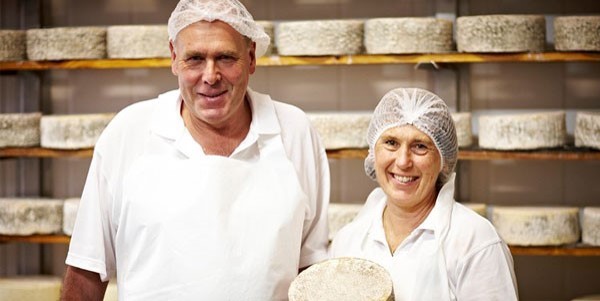Unlocking the Keys of Artisanal Cheese Making: A Step-by-Step DIY Overview
In the realm of cooking workmanship, artisanal cheese making stands as a testimony to the fragile equilibrium in between tradition and development. Each step in the process, from choosing the right milk to perfecting aging techniques, holds within it a wide range of knowledge gave with generations. As we start this trip to demystify the art of producing beautiful cheeses, we are confronted with a tapestry of abilities and tricks waiting to be unraveled. Join us as we check out the ins and outs of this ancient craft, where scientific research, art, and patience assemble to generate flavors that tantalize the senses.
Choosing the Right Milk
When embarking on the journey of artisanal cheese making, the choice of milk plays a critical function in identifying the quality and characteristics of the end product. The kind of milk selected affects the taste, texture, and overall account of celebrity. Raw milk, directly from the animal, is chosen by many artisanal cheesemakers due to its unique mix of enzymes, microorganisms, and flavor compounds. However, utilizing raw milk comes with guidelines and threats, making sterilized milk a safer alternative for beginners.
When picking milk for cheese making, it is vital to consider the fat content. Greater fat web content in milk can result in a creamier and richer cheese, while lower fat material might cause a drier and firmer texture. In addition, the source of the milk, whether from cows, goats, sheep, or buffalo, adds distinctive flavors and attributes to the cheese (Cheese Makers Melbourne). Each kind of milk brings its very own nuances, enabling a vast array of cheese varieties to be crafted based on the selected milk. Inevitably, the option of milk is a basic choice that establishes the structure for an effective artisanal cheese-making venture.
Culturing and Coagulating
To start the cheese-making procedure, the crucial steps of culturing and coagulating have to be very carefully implemented to transform milk into curds and whey. The kind of culture utilized can significantly affect the flavor, texture, and ripening of the final cheese product.

The timing and temperature level control throughout culturing and coagulation are critical elements that influence the final outcome of celebrity. Correct implementation of these steps is important to guarantee the desired texture, flavor, and uniformity of the artisanal cheese being created.
Draining Pipes and Pressing Curds
After the milk healthy proteins have actually coagulated and the curds have actually been cut to release whey, the next important action in artisanal cheese making entails draining and pushing the curds to achieve the preferred texture and uniformity of the final cheese item. Draining is the process go to this site of dividing the curds from the whey. This can be done by moving the curds into a cheesecloth-lined bowl-shaped sieve or mold and allowing the whey to drain off naturally. The time for draining pipes can vary relying on the type of cheese being made and the preferred moisture material.
Pressing assists get rid of any remaining whey and compacts the curds to develop a strong cheese wheel. Correct pressing and draining pipes are vital steps that significantly impact the top quality and qualities of the artisanal cheese being created.
Aging and Flavor Methods
Executing meticulous aging and flavoring methods is crucial in boosting the depth and intricacy of artisanal cheeses, boosting their taste accounts to charming levels of improvement and sophistication. Aging plays an important role in developing the distinct tastes and textures that differentiate artisanal cheeses. Throughout the aging procedure, cheeses are kept in carefully controlled settings where factors such as air flow, temperature level, and moisture are manipulated to urge the growth of beneficial mold and mildews and microorganisms. This regulated setting enables celebrity to grow gradually, establishing complicated fragrances and abundant flavors.
Seasoning techniques additionally add significantly to the final preference of artisanal cheeses. Cheesemakers may pick to present extra flavors by incorporating ingredients such as herbs, spices, or also fruits right into celebrity throughout the manufacturing process. In addition, some cheeses are washed or rubbed with different fluids, such as brine or alcohol, to enhance their textures and tastes.
Covering and Saving Cheeses

Final Thought
In conclusion, understanding the art of artisanal cheese making includes very carefully choosing the best milk, adhering to exact culturing and coagulating procedures, draining pipes and pushing curds successfully, and using various aging and flavoring techniques. Remember to cover and keep your cheeses properly to ensure optimal taste and structure growth.
Each kind of milk brings its own subtleties, permitting for a broad range of cheese ranges to be crafted based on the picked milk.After the milk proteins have actually coagulated and the curds have been reduced to release whey, the next crucial step in artisanal cheese making entails draining and pressing the curds to attain the preferred texture and uniformity of the final cheese item. The majority of cheeses need to be wrapped in wax paper or cheese paper to allow them to breathe while protecting them from drying out. For cheeses that need to proceed aging, such as bloomy skins or washed peels, ensure they are saved in an awesome environment like a cheese cavern or read what he said a fridge set to the suitable temperature. By paying focus to the covering and storage of artisanal cheeses, cheese makers and enthusiasts can maintain the integrity of these specials and fully enjoy their intricate tastes.